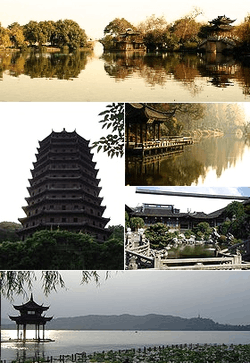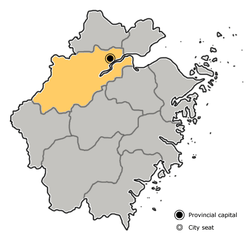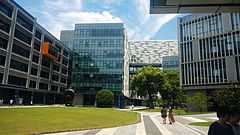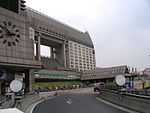Hangzhou
| ||||||||||||||||||||||||||||||||||||||||||||||||||||||||||||||||||||||||||||||||||||||||||||||||||||||||||||||||||||||||||||||||||||||||||||||||||||||||||||||||||
Hangzhou (/ˈhɑːŋˈdʒoʊ/,[4] ![]() listen ), formerly romanised as Hangchow, is the capital and largest city of Zhejiang Province in Eastern China.[5] It sits at the head of Hangzhou Bay on China's coast between Shanghai and Ningbo. Hangzhou grew to prominence as the southern terminus of the Grand Canal and has been one of the most renowned and prosperous cities in China for much of the last millennium, due in part to its beautiful natural scenery. The city's West Lake is its best-known attraction.
listen ), formerly romanised as Hangchow, is the capital and largest city of Zhejiang Province in Eastern China.[5] It sits at the head of Hangzhou Bay on China's coast between Shanghai and Ningbo. Hangzhou grew to prominence as the southern terminus of the Grand Canal and has been one of the most renowned and prosperous cities in China for much of the last millennium, due in part to its beautiful natural scenery. The city's West Lake is its best-known attraction.
Hangzhou is classified as a sub-provincial city[6] and forms the core of the Hangzhou Metropolitan Area,[3] the fourth-largest metropolitan area in China.[7] During the 2010 Chinese census, the metropolitan area held 21.102 million people over an area of 34,585 km2 (13,353 sq mi).[3] Hangzhou prefecture had a registered population of 8.7 million[8] and the built-up area (including the 9 urban districts and the Keqiao and Yuecheng districts of Shaoxing) held 8,874,348.
History
Early history

The celebrated neolithic culture of Hemudu is known to have inhabited Yuyao, 100 km (62 mi) south-east of Hangzhou, as far back as seven thousand years ago.[9] It was during this time that rice was first cultivated in southeastern China.[10] Excavations have established that the jade-carving Liangzhu culture (named for its type site just northwest of Hangzhou) inhabited the area immediately around the present city around five thousand years ago.[11]
The first of Hangzhou's present neighborhoods to appear in written records was Yuhang, which probably preserves an old Baiyue name.[12]
Hangzhou was made the seat of the zhou (very roughly, "county") of Hang in AD 589, entitling it to a city wall which was constructed two years later. By a longstanding convention also seen in other cities like Guangzhou and Fuzhou, the city took on the name of the area it administered and became known as Hangzhou. Hangzhou was at the southern end of China's Grand Canal which extends to Beijing. The canal evolved over centuries but reached its full length by 609.[13]
It is listed as one of the Seven Ancient Capitals of China. It was first the capital of the Wuyue Kingdom from 907 to 978 during the Five Dynasties and Ten Kingdoms Period. Named Xifu at the time,[14] it was one of the three great bastions of culture in southern China during the tenth century, along with Nanjing and Chengdu.[15] Leaders of Wuyue were noted patrons of the arts, particularly of Buddhist temple architecture and artwork. Hangzhou also became a cosmopolitan center, drawing scholars from throughout China and conducting diplomacy with neighboring Chinese states, and also with Japan, Korea, and the Khitan Liao dynasty.
In the Tang dynasty, Bai Juyi was appointed governor of Hangzhou.[16] Already an accomplished and famous poet, his deeds at Hangzhou have led to his being praised as a great governor. He noticed that the farmland nearby depended on the water of West Lake, but due to the negligence of previous governors, the old dyke had collapsed, and the lake so dried out that the local farmers were suffering from severe drought. He ordered the construction of a stronger and taller dyke, with a dam to control the flow of water, thus providing water for irrigation and mitigating the drought problem. The livelihood of local people of Hangzhou improved over the following years. Bai Juyi used his leisure time to enjoy the beauty of West Lake, visiting it almost daily. He also ordered the construction of a causeway connecting Broken Bridge with Solitary Hill to allow walking, instead of requiring a boat. He then had willows and other trees planted along the dyke, making it a beautiful landmark. This causeway was later named "Bai Causeway", in his honor.
In 1089, while another renowned poet Su Shi (Su Dongpo) was the city's governor, he used 200,000 workers to construct a 2.8 km (1.7 mi) long causeway across West Lake, which Qing Emperor Qianlong considered particularly attractive in the early morning of the spring time. The lake was once a lagoon tens of thousands of years ago. Silt then blocked the way to the sea and the lake was formed. A drill in the lake-bed in 1975 found the sediment of the sea, which confirmed its origin. Artificial preservation prevented the lake from evolving into a marshland. The Su Causeway built by Su Shi, and the Bai Causeway built by Bai Juyi, a Tang dynasty poet who was once the governor of Hangzhou, were both built out of mud dredged from the lake bottom. The lake is surrounded by hills on the northern and western sides. The Baochu Pagoda sits on the Baoshi Hill to the north of the lake.
Foreign community

Arab merchants lived in Hangzhou during the Song dynasty, due to the fact that the oceangoing trade passages took precedence over land trade during this time.[17] There were also Arabic inscriptions from the 1200s and 1300s. During the later period of the Yuan dynasty, Muslims were persecuted through the banning of their traditions, and they participated in revolts against the Mongols.[18] The Fenghuangshi mosque was constructed by an Egyptian trader who moved to Hangzhou.[19] Ibn Battuta is known to have visited the city of Hangzhou in 1345; he noted its charm and described how the city sat on a beautiful lake and was surrounded by gentle green hills.[20] During his stay at Hangzhou, he was particularly impressed by the large number of well-crafted and well-painted Chinese wooden ships with colored sails and silk awnings in the canals. He attended a banquet held by Qurtai, the Yuan Mongol administrator of the city, who according to Ibn Battuta, was fond of the skills of local Chinese conjurers.[21]
Southern Song

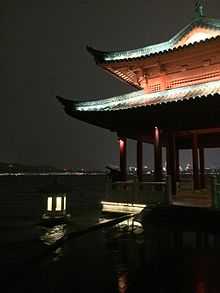
Hangzhou was chosen as the new capital of the Southern Song dynasty in 1132,[22] when most of northern China had been conquered by the Jurchens in the Jin–Song wars.[23] The Song court had retreated south to the city in 1129 from its original capital in Kaifeng, after it was captured by the Jurchens in the Jingkang Incident of 1127.[24][25] From Kaifeng they moved to Nanjing, modern Shangqiu, then to Yangzhou in 1128.[24] The government of the Song intended it to be a temporary capital. However, over the decades Hangzhou grew into a major commercial and cultural center of the Song dynasty. It rose from a middling city of no special importance to one of the world's largest and most prosperous.[26] Once the prospect of retaking northern China had diminished, government buildings in Hangzhou were extended and renovated to better befit its status as an imperial capital and not just a temporary one. The imperial palace in Hangzhou, modest in size, was expanded in 1133 with new roofed alleyways, and in 1148 with an extension of the palace walls.[27]
From the early 12th century until the Mongol invasion of 1276, Hangzhou remained the capital and was known as Lin'an. It served as the seat of the imperial government, a center of trade and entertainment, and the nexus of the main branches of the civil service. During that time the city was a gravitational center of Chinese civilization: what used to be considered "central China" in the north was taken by the Jin, an ethnic minority dynasty ruled by Jurchens.
Numerous philosophers, politicians, and men of literature, including some of the most celebrated poets in Chinese history such as Su Shi, Lu You, and Xin Qiji came here to live and die. Hangzhou is also the birthplace and final resting place of the scientist Shen Kuo (1031–1095 AD), his tomb being located in the Yuhang district.[28]
During the Southern Song dynasty, commercial expansion, an influx of refugees from the conquered north, and the growth of the official and military establishments, led to a corresponding population increase and the city developed well outside its 9th century ramparts. According to the Encyclopædia Britannica, Hangzhou had a population of over 2 million at that time, while historian Jacques Gernet has estimated that the population of Hangzhou numbered well over one million by 1276. (Official Chinese census figures from the year 1270 listed some 186,330 families in residence and probably failed to count non-residents and soldiers.) It is believed that Hangzhou was the largest city in the world from 1180 to 1315 and from 1348 to 1358.[29][30]
Because of the large population and densely crowded (often multi-story) wooden buildings, Hangzhou was particularly vulnerable to fires. Major conflagrations destroyed large sections of the city in 1132, 1137, 1208, 1229, 1237, and 1275 while smaller fires occurred nearly every year. The 1237 fire alone was recorded to have destroyed 30,000 dwellings. To combat this threat, the government established an elaborate system for fighting fires, erected watchtowers, devised a system of lantern and flag signals to identify the source of the flames and direct the response, and charged more than 3,000 soldiers with the task of putting out fires.
Yuan dynasty
The city of Hangzhou was besieged and captured by the advancing Mongol armies of Kublai Khan in 1276, three years before the final collapse of the empire.[31] The capital of the new Yuan Dynasty was established in the city of Dadu (Beijing).[32]
The Venetian merchant Marco Polo supposedly visited Hangzhou in the late 13th century. In his book, he records that the city was "greater than any in the world".[26] He called the city Kinsay, Quinsai, or Kinsai, which is unrelated to its then-current names but seems to be a Persianized form of the Chinese word for "capital". Although he exaggerated that the city was over one hundred miles in diameter and had 12,000 stone bridges, he still presented elegant prose about the country: "The number and wealth of the merchants, and the amount of goods that passed through their hands, was so enormous that no man could form a just estimate thereof." The renowned 14th century Moroccan explorer Ibn Battuta said it was "the biggest city I have ever seen on the face of the earth."[33][34]
Ming and after
The city remained an important port until the middle of the Ming dynasty era, when its harbor slowly silted up.
In 1856 and 1860, the Taiping Heavenly Kingdom occupied Hangzhou and caused heavy damage to the city.
Hangzhou was ruled by the Republic of China government under the Kuomintang from 1928 to 1949. On May 3, 1949, the People's Liberation Army entered Hangzhou and the city came under Communist control. After Deng Xiaoping's reformist policies began in 1978, Hangzhou took advantage of being situated in the Yangtze River Delta to bolster its development. It is now one of China's most prosperous major cities.
Jewish community
As late as the latter part of the 16th and early 17th centuries, the city was an important center of Chinese Jewry, and may have been the original home of the better-known Kaifeng Jewish community.[35]
There was formerly a Jewish synagogue in Ningbo, as well as one in Hangzhou, but no traces of them are now discoverable, and the only Jews known to exist in China were in Kaifeng.[36]
Muslim communities during Ming and Qing dynasties
In 1848, during the Qing dynasty, Hangzhou was described as the "stronghold" of Islam in China, the city containing several mosques with Arabic inscriptions.[37] A Hui from Ningbo also told an Englishman that Hanzhou was the "Stronghold" of Islam in Zhejiang province, containing multiple mosques, compared to his small congregation of around 30 families in Ningbo for his Mosque.[38]
Within the city of Hangzhou are two notable mosques: Great Mosque of Hangzhou and the Phoenix Mosque.
Geography and climate
| Hangzhou | ||||||||||||||||||||||||||||||||||||||||||||||||||||||||||||
|---|---|---|---|---|---|---|---|---|---|---|---|---|---|---|---|---|---|---|---|---|---|---|---|---|---|---|---|---|---|---|---|---|---|---|---|---|---|---|---|---|---|---|---|---|---|---|---|---|---|---|---|---|---|---|---|---|---|---|---|---|
| Climate chart (explanation) | ||||||||||||||||||||||||||||||||||||||||||||||||||||||||||||
| ||||||||||||||||||||||||||||||||||||||||||||||||||||||||||||
| ||||||||||||||||||||||||||||||||||||||||||||||||||||||||||||
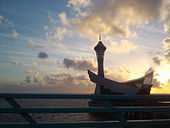

Hangzhou is located in northwestern Zhejiang province, at the southern end of the Grand Canal of China, which runs to Beijing, in the south-central portion of the Yangtze River Delta. Its administrative area (sub-provincial city) extends west to the mountainous parts of Anhui province, and east to the coastal plain near Hangzhou Bay. The city center is built around the eastern and northern sides of the West Lake, just north of the Qiantang River.
Hangzhou's climate is humid subtropical (Köppen Cfa) with four distinctive seasons, characterised by long, very hot, humid summers and chilly, cloudy and drier winters (with occasional snow). The mean annual temperature is 17.0 °C (62.6 °F), with monthly daily averages ranging from 4.6 °C (40.3 °F) in January to 28.9 °C (84.0 °F) in July. The city receives an average annual rainfall of 1,438.0 mm (56.6 in) and is affected by the plum rains of the Asian monsoon in June. In late summer (August to September), Hangzhou suffers typhoon storms, but typhoons seldom strike it directly. Generally they make landfall along the southern coast of Zhejiang, and affect the area with strong winds and stormy rains.[39] Extreme temperatures have ranged from −10.5 to 42.1 °C (13 to 108 °F).[40] With monthly percent possible sunshine ranging from 30% in March to 51% in August, the city receives 1,709.4 hours of sunshine annually.
| Climate data for Hangzhou 1981–2010 Normals (Extremes 1951–present) | |||||||||||||
|---|---|---|---|---|---|---|---|---|---|---|---|---|---|
| Month | Jan | Feb | Mar | Apr | May | Jun | Jul | Aug | Sep | Oct | Nov | Dec | Year |
| Record high °C (°F) | 23.9 (75) |
28.5 (83.3) |
32.8 (91) |
34.8 (94.6) |
36.5 (97.7) |
39.7 (103.5) |
40.5 (104.9) |
41.6 (106.9) |
38.7 (101.7) |
35.0 (95) |
31.2 (88.2) |
26.5 (79.7) |
41.6 (106.9) |
| Average high °C (°F) | 8.3 (46.9) |
10.3 (50.5) |
14.8 (58.6) |
21.1 (70) |
26.3 (79.3) |
29.1 (84.4) |
33.6 (92.5) |
32.8 (91) |
28.2 (82.8) |
23.2 (73.8) |
17.3 (63.1) |
11.3 (52.3) |
21.4 (70.5) |
| Daily mean °C (°F) | 4.6 (40.3) |
6.4 (43.5) |
10.3 (50.5) |
16.2 (61.2) |
21.4 (70.5) |
24.7 (76.5) |
28.9 (84) |
28.2 (82.8) |
24.0 (75.2) |
18.8 (65.8) |
12.9 (55.2) |
7.0 (44.6) |
17.0 (62.6) |
| Average low °C (°F) | 1.8 (35.2) |
3.5 (38.3) |
7.0 (44.6) |
12.4 (54.3) |
17.5 (63.5) |
21.4 (70.5) |
25.2 (77.4) |
24.9 (76.8) |
20.9 (69.6) |
15.4 (59.7) |
9.3 (48.7) |
3.7 (38.7) |
13.6 (56.5) |
| Record low °C (°F) | −8.6 (16.5) |
−9.6 (14.7) |
−3.5 (25.7) |
0.2 (32.4) |
7.3 (45.1) |
12.8 (55) |
17.5 (63.5) |
18.2 (64.8) |
12.0 (53.6) |
1.0 (33.8) |
−3.6 (25.5) |
−8.4 (16.9) |
−9.6 (14.7) |
| Average precipitation mm (inches) | 80.6 (3.173) |
88.2 (3.472) |
140.7 (5.539) |
123.1 (4.846) |
128.6 (5.063) |
219.4 (8.638) |
172.9 (6.807) |
162.1 (6.382) |
123.5 (4.862) |
78.5 (3.091) |
71.5 (2.815) |
48.9 (1.925) |
1,438 (56.614) |
| Avg. precipitation days (≥ 0.1 mm) | 12.4 | 12.1 | 15.3 | 14.5 | 13.8 | 14.6 | 12.4 | 13.8 | 11.7 | 9.0 | 9.3 | 8.5 | 147.4 |
| Average relative humidity (%) | 75 | 75 | 75 | 74 | 74 | 80 | 76 | 78 | 79 | 76 | 74 | 73 | 75.7 |
| Mean monthly sunshine hours | 102.0 | 97.2 | 116.4 | 140.6 | 164.7 | 136.6 | 212.7 | 193.0 | 143.9 | 144.6 | 129.0 | 128.7 | 1,709.4 |
| Source: China Meteorological Data Sharing Service System[41] | |||||||||||||
Administrative divisions
The sub-provincial city of Hangzhou comprises 9 districts, 2 county-level cities, and 2 counties. The six central urban districts occupy 683 km2 (264 sq mi) and have 3,560,400 people. The three suburban districts occupy 4,193 km2 (1,619 sq mi) and have 3,399,300 people.
| Map | № | Subdivision | Chinese | Pinyin | Population (2010) | Area (km2) | Density |
|---|---|---|---|---|---|---|---|
 | |||||||
| City Proper | |||||||
| 1 | Shangcheng District | 上城区 | Shàngchéng Qū | 344,594 | 18.30 | 18,830.27 | |
| 2 | Xiacheng District | 下城区 | Xiàchéng Qū | 526,096 | 31.46 | 16,722.70 | |
| 3 | Jianggan District | 江干区 | Jiānggàn Qū | 998,783 | 210.22 | 4,751.13 | |
| 4 | Gongshu District | 拱墅区 | Gǒngshù Qū | 551,874 | 87.49 | 6,307.85 | |
| 5 | Xihu District | 西湖区 | Xīhú Qū | 820,017 | 308.70 | 2,656.36 | |
| 6 | Binjiang District | 滨江区 | Bīnjiāng Qū | 319,027 | 72.02 | 4,429.70 | |
| Suburban | |||||||
| 7 | Xiaoshan District | 萧山区 | Xiāoshān Qū | 1,511,290 | 1,420.22 | 1,064.12 | |
| 8 | Yuhang District | 余杭区 | Yúháng Qū | 1,170,290 | 1,223.56 | 956.46 | |
| 10 | Fuyang District | 富阳区 | Fùyáng Qū | 717,694 | 1,831.20 | 391.93 | |
| County | |||||||
| 12 | Tonglu County | 桐庐县 | Tónglú Xiàn | 406,450 | 1,825.00 | 222.71 | |
| 13 | Chun'an County | 淳安县 | Chún'ān Xiàn | 336,843 | 4,427.00 | 76.09 | |
| County-level cities | |||||||
| 9 | Jiande | 建德市 | Jiàndé Shì | 430,750 | 2,321.00 | 185.59 | |
| 11 | Lin'an | 临安市 | Lín'ān Shì | 566,665 | 3,126.80 | 181.23 | |
Economy

Hangzhou's economy has rapidly developed since its opening up in 1992. It is an industrial city with many diverse sectors such as light industry, agriculture, and textiles. It is considered an important manufacturing base and logistics hub for coastal China.[42]
The 2001 GDP of Hangzhou was RMB ¥156.8 billion, which ranked second among all of the provincial capitals after Guangzhou. The city has more than tripled its GDP since then, increasing from RMB ¥156.8 billion in 2001 to RMB ¥701.1 billion in 2011 and GDP per capita increasing from US$3,025 to US$12,447.[42][43]
The city has developed many new industries, including medicine, information technology, heavy equipment, automotive components, household electrical appliances, electronics, telecommunication, fine chemicals, chemical fibre and food processing.[44]
Economic and Technological Development Zones
- Hangzhou Economic & Technological Development Zone. It was established and approved as a national development zone by State Council in 1993. It covers an area of 104.7 km2 (40.4 sq mi). Encouraged industries include electronic information, biological medicine, machinery manufacturing, and food processing.[45]
- Hangzhou Export Processing Zone. It was established on April 27, 2000 upon approval of the State Council. It was one of the first zones and the only one in Zhejiang Province to be approved by the government. Its total planned area is 2.92 km2. It is located close to Hangzhou Xiaoshan International Airport and Hangzhou Port.[46]
- Hangzhou Hi-Tech Industrial Development Zone (abbreviated to Hi-tech Zone). It was set up after receiving approval from the State Council as a state level Hi-tech Industrial Development Zone in March 1991. The Hangzhou Hi-tech Zone is composed of three parts, with the main regions being the Zhejiang Sci-Tech Industrial Park and Xiasha Sci-Tech Industrial Park. The Hi-tech Zone makes good use of the concentrated superior intelligence in the park zone, relies on Hangzhou city's richly endowed natural environment and depends on preferential investment policies to gradually build a scientifically based hi-tech city --- Paradise Silicon Valley will capture world attention.[47]
Tourism
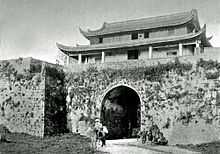

Hangzhou is renowned for its historic relics and natural beauty. It is known as one of the most beautiful cities in China, also ranking as one of the most scenic cities. Although Hangzhou has been through many recent urban developments, it still retains its historical and cultural heritage. Today, tourism remains an important factor for Hangzhou's economy.[48] One of Hangzhou's most popular sights is West Lake, a UNESCO World Heritage Site. The West Lake Cultural Landscape covers an area of 3,323 ha (8,210 acres) and includes some of Hangzhou's most notable historic and scenic places. Adjacent to the lake is a scenic area which includes historical pagodas, cultural sites, as well as the natural beauty of the lake and hills, including Phoenix Mountain. There are two causeways across the lake.[48]
Other places of interest:
- The world's largest tidal bore races up the Qiantang River through Hangzhou reaching up to 12 m (39 ft) in height.
- The Residence of Hu Xueyan (胡雪岩故居) located on Yuanbao Street was built in 1872 by Hu Xueyan, a native of Anhui, a very successful businessman. It was restored and opened to the public in 2001.
- Xixi National Wetland Park. Established with the aim of preserving the wetland ecological system, it covers an area of about 10km2. Fish ponds and reed beds have been restored and it is home to many types of birds. It holds a temple and several historic rural houses.
- Hangzhou Botanical Garden
- Hangzhou Zoo
- Old China Street on He Fang Street (He Fang Jie), which offers various souvenirs and renowned Longjing tea.
- Jade Springs (Yu Quan)
- West Lake Cultural Square is the tallest building in the city and houses the Zhejiang Natural History Museum and Zhejiang Museum of Science and Technology.
- Qiandao Lake is a man-made lake with the largest number of islands. These islands are different in size and shape, and have distinctive scene.
- Grand Canal
- Tianducheng, a 31-km² housing development outside Hangzhou. It contains a subscale replica of the French Eiffel Tower and hundreds of French-architecture-influenced buildings.
In March 2013 The Hangzhou Tourism Commission started an online campaign via Facebook, the 'Modern Marco Polo' campaign. Over the next year nearly 26,000 participants applied from around the globe, in the hopes of becoming Hangzhou's first foreign tourism ambassador.[49] In a press conference in Hangzhou on May 20, 2014, Liam Bates was announced as the successful winner. The 26-year-old won a €40,000 contract and is the first foreigner ever to be appointed by China's government in such an official role.[50]
Religion
.jpg)

Scenic places near West Lake
- Jingci Temple is located just south of West Lake.
- Lingyin Temple (Soul's Retreat) is located about 2 km (1.2 mi) west of West Lake. This is believed to be the oldest Buddhist temple in the city, which has gone through numerous destruction and reconstruction cycles.
- Baochu Pagoda is located just north of West Lake on Precious Stone Hill (宝石山)
- Yue-Wang Temple (King Yue's Temple) or Yue Fei Miao is on the northwest shore of West Lake. It was originally constructed in 1221 in memory of General Yue Fei, who lost his life due to political persecution.
- Leifeng Pagoda, located on Sunset Hill south of West Lake.
Other religious buildings
- Liuhe Pagoda or six harmonies pagoda is located on Yuelun Hill on the north bank of Qiantang River
- Confucius Temple
- Chenghuangmiao (City God Pavilion) located on Wushan (Wu Hill)
- Dreaming of the Tiger Spring
- The Immaculate Conception Cathedral of Hangzhou is one of the oldest Catholic churches in China, dating back 400 years to the Ming dynasty.
- Fenghuang Temple (凤凰清真寺) is one of the oldest mosques in China, the current construction at the intersection of Xihu Avenue (西湖大道) and the Central Zhongshan Road (中山中路) dates back 700 years to the Yuan dynasty.
Christianity
Two of the Three Pillars of Chinese Catholicism were from Hangzhou. In Hangzhou, there was persecution of Christians in the early 21st century.[51]
Culture
Language

The native residents of Hangzhou, like those of Zhejiang and southern Jiangsu, speak a Wu dialect. However, the Wu dialect varies throughout the area where it is spoken, hence, Hangzhou's dialect differs from regions in southern Zhejiang and southern Jiangsu. As the official language defined by China's central government, Mandarin is the dominant spoken language.
Museum
There are several museums located in Hangzhou with regional and national importance. China National Silk Museum (中国丝绸博物馆), located near the West Lake, is one of the first state-level museums in China and the largest silk museum in the world. China National Tea Museum (中国茶叶博物馆)is a national museum with special subjects as tea and its culture. Zhejiang Provincial Museum (浙江博物馆)features collection of integrated human studies, exhibition and research with its over 100,000 collected cultural relics.
Food
Hangzhou's local cuisine is often considered to be representative of Zhejiang provincial cuisine, which is claimed as one of China’s eight fundamental cuisines. The locally accepted consensus among Hangzhou's natives defines dishes prepared in this style to be "fresh, tender, soft, and smooth, with a mellow fragrance."
Dishes like Pian Er Chuan Noodles (片儿川) West Lake Vinegar Fish (西湖醋鱼), Dongpo Pork (东坡肉), Longjing Shrimp (龙井虾仁), Beggar's Chicken (叫化鸡), Steamed Rice and Pork Wrapped by Lotus Leaves(荷叶粉蒸肉), Braised Bamboo Shoots (油焖笋),Lotus Root Pudding (藕粉)and Sister Song's Fish Soup (宋嫂鱼羹) are some of the better-known examples of Hangzhou's regional cuisine.
There are many restaurants in Hangzhou where you can taste the typical Hangzhou dishes. Lou Wai Lou is a famous restaurant located near the beautiful West Lake, which services the traditional dishes like Beggar's Chicken, West Lake Vinegar Fish. Zhi Wei Guan Restaurant is famous for the traditional dishes and sacks like Xiao Long Bao, Streamed Buns, Cat's Ear Noodles. Kui Yuan Guan's noodle is a must-do for tourists to Hangzhou. There are also restaurants like Granma's Kitchen which provide local dishes with real value-to-money experience.
Arts
There are lots of theaters in Hangzhou showing performance of opera shows. Yue Opera, originated from Shengzhou, Zhejiang Province, is the second-largest opera form in China. Also, there are several big shows themed with the history and culture of Hangzhou like Impression West Lake and the Romance of Song Dynasty.
Specialty
Tea is an important part of Hangzhou's economy and culture. Hangzhou is best known for originating Longjing, a notable variety of green tea, the most notable type being Xi Hu Long Jing.[52] Known as the best type of Long Jing tea, Xi Hu Long Jing is grown near Xi Hu in Hangzhou, hence its name.
The local government of Hangzhou heavily invests in promoting tourism and the arts, with emphasis placed upon silk production, umbrellas, and Chinese hand-held folding fans.
Transportation
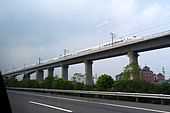

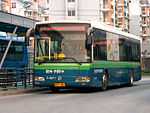
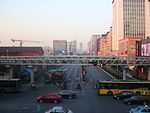

Hangzhou is served by the Hangzhou Xiaoshan International Airport, which provides direct service to many international destinations such as Thailand, Japan, South Korea, Malaysia, India, Vietnam, Ethiopia, Singapore, and the Netherlands.[53] Regional routes reach Hong Kong, Taiwan and Macau. It has an extensive domestic route network within the PRC and is consistently ranked top 10 in passenger traffic among Chinese airports. Hangzhou Xiaoshan International Airport has two terminals, Terminal A and Terminal B. The smaller Terminal A serves all international and regional flights while the larger Terminal B solely handles domestic traffic. The airport is located just outside the city in the Xiaoshan District with direct bus service linking the airport with Downtown Hangzhou. The ambitious expansion project will see the addition of a second runway and a third terminal which will dramatically increase capacity of the fast-growing airport that serves as a secondary hub of Air China. A new elevated airport express highway is under construction on top of the existing highway between the airport and downtown Hangzhou. The second phase of Hangzhou Metro Line 1 has a planned extension to the airport.
Hangzhou sits on the intersecting point of some of the busiest rail corridors in China. The city's main station is Hangzhou East Railway Station (colloquially "East Station" 东站). It is one of the biggest rail traffic hubs in China consisting of 15 platforms that house the High Speed CRH service to Shanghai, Nanjing, Changsha, Ningbo, and beyond. The subway station beneath the rail complex building is a stop along the Hangzhou Metro Line 1. There are frequent departures for Shanghai with approximately 20-minute headways from 6:00 to 21:00. Non-stop CRH high-speed service between Hangzhou and Shanghai takes 50 minutes and leaves every hour (excluding a few early morning/late night departures) from both directions. While other CRH high-speed trains that stop at one or more stations along the route complete the trip in 59 to 75 minutes. Most other major cities in China can also be reached by direct train service from Hangzhou. The Hangzhou Railway Station (colloquially the "City Station" Chinese: 城站) was closed for renovation in mid 2013 but has recently opened again.
Direct trains link Hangzhou with more than 50 cities, including 12 daily services to Beijing, more than 100 daily services to Shanghai and it reaches as far as Ürümqi. The China Railway High-Speed service inaugurated on October 26, 2010. The service is operated by the CRH 380A(L), CRH 380B(L) and CRH380CL train sets which travel at a maximum speed of 350 km/h (220 mph), shortening the duration of the 202 km (126 mi) trip to only 45 minutes.[54]
The construction of the Shanghai–Hangzhou Maglev Train Line has been debated for several years. On August 18, 2008 Beijing Authorities gave the project the go-ahead to start construction in 2010. Transrapid has been contracted to construct the line. However, as of 2011 construction has not yet started.
Central, north, south and west long-distance bus stations offer frequent coach service to nearby cities/towns within Zhejiang province, as well as surrounding provinces.[55]
Hangzhou has an efficient public transportation network, consisting of a modern fleet of regular diesel bus, trolley bus, hybrid diesel-electric bus and taxi. The first subway line entered into service in late 2012. Hangzhou is known for its extensive Bus Rapid Transit network expanding from downtown to many suburban areas through dedicated bus lanes on some of the busiest streets in the city. Bicycles and electric scooters are very popular and major streets have dedicated bike lanes throughout the city. Hangzhou has an extensive free public bike rental system, the Hangzhou Public Bicycle system.
Taxis are also popular in the city. With its line of the newest Hyundai Sonatas and Volkswagen Passats, and tight regulations. In early 2011, 30 electric taxis were deployed in Hangzhou. 15 were Zoyte Langyues and the other 15 were Haima Freemas, however in April one Zoyte Langye caught fire and all of the electric taxis were taken off the roads later that day. The city still intends to have a fleet of 200 electric taxis by the end of 2011.[56]
The Hangzhou Metro began construction in March 2006 and the first line opened on November 24, 2012. Line 1 connects downtown Hangzhou with suburban areas of the city from Xianghu to Wenze Road and Linping. It is expected to have 8 lines upon completion. Most lines are still under construction.
Education
Universities
Hangzhou has a large student population with many higher education institutions based in the city. Public universities include Zhejiang University, Zhejiang University of Technology, and Hangzhou Normal University etc. Xiasha, located near the east end of the city, and Xiaoheshan, located near the west end of the city, are college towns with a cluster of several universities and colleges.
- China Academy of Art (founded in 1928)
- Hangzhou Dianzi University
- Hangzhou Normal University (founded in 1908)
- Zhejiang Chinese Medical University
- Zhejiang Forestry University
- Zhejiang Gongshang University
- Zhejiang International Studies University (also known as Zhejiang Education Institute, founded in 1955 and started enrolling full-time undergraduates in 1994, got its present name in 2010)[57]
- Zhejiang Sci-Tech University
- Zhejiang University (founded in 1897), one of the top five universities in China.[58] (Project 985, Project 211, C9 League)
- Zhejiang University City College
- Zhejiang University of Technology (1953)
Note: Institutions without full-time bachelor programs are not listed.
High schools
The most famous high schools in Hangzhou are:
- Hangzhou High School (Formerly Hangzhou No.1 Senior High School)
- Hangzhou Foreign Language School
- High school attached to Zhejiang University(Formerly Hangzhou No.15 Senior High School)
- High School attached to Hangzhou Normal university(Formerly Hangzhou No.13 Senior High School)
- Hangzhou No.2 High School
- Hangzhou No.4 High School
- Hangzhou No.7 High School
- Hangzhou Xuejun High School
- Hangzhou No.9 High School
- Hangzhou No.11High School
- Hangzhou No.14 High School
Hangzhou International School serves the local expat population in Hangzhou.
Sister cities
| City | Country | since |
|---|---|---|
| Sayama | | 1978 |
| Gifu | | 1979 |
| Boston | | 1982 |
| Baguio | | 1982 |
| Leeds | | 1988 |
| Fukui | | 1989 |
| Yeosu | | 1994 |
| Nice | | 1994 |
| Paramaribo | | 1988 |
| Budapest | | 1999 |
| Beit Shemesh | | 2000 |
| Dresden | | 2009 |
| Indianapolis | | 2009 |
Chinese sayings
- "Be born in Suzhou, live in Hangzhou, eat in Guangzhou, die in Liuzhou." (simplified Chinese: 生在苏州, 活在杭州, 吃在广州, 死在柳州; traditional Chinese: 生在蘇州, 活在杭州, 吃在廣州, 死在柳州)
- The meaning here lies in the fact that Suzhou was renowned for its beautiful and highly civilized and educated citizens, Hangzhou for its scenery, Guangzhou for its food, and Liuzhou (of Guangxi) for its wooden coffins which supposedly halted the decay of the body.
- "Heaven Above, Suzhou and Hangzhou below." (simplified Chinese: 上有天堂, 下有苏杭; traditional Chinese: 上有天堂, 下有蘇杭)
- This phrase has a similar meaning to the English phrases "heaven on Earth" or "God's country".
See also
- Hangzhou No.14 high school
- Hangzhou Binjiang Hospital, Zhejiang University
- Jiangnan
- List of cities in the People's Republic of China by population
- Suzhou numerals - in the Unicode standard version 3.0, these characters are incorrectly named Hangzhou style numerals
References
- ↑ http://www.citypopulation.de/php/china-zhejiang-admin.php
- ↑ 杭州市 2010年国民经济和社会发展统计公报 (in Chinese). Hangzhou Municipal Statistic Bureau. 2011-02-24. Retrieved 2011-09-15.
- ↑ 3.0 3.1 3.2 3.3 Economic and Social Development Report of Hangzhou Metropolitan Circles (2007-2012) (in Chinese). Social Sciences Academic Press(China). 2012-10-01. Retrieved 2013-02-20.
- ↑ "Hangzhou pronunciation". Dictionary.com. Retrieved 25 April 2015.
- ↑ "Illuminating China's Provinces, Municipalities and Autonomous Region". PRC Central Government Official Website. 2001. Retrieved 2014-04-22.
- ↑ "中央机构编制委员会印发《关于副省级市若干问题的意见》的通知. 中编发[1995]5号". 豆丁网. 1995-02-19. Retrieved 2014-05-28.
- ↑ "2012中国都市圈评价指数今年7月发布" (in Simplified Chinese). 上海交通大学. 2012-07-02. Retrieved 2013-02-20.
- ↑ [http://zjnews.zjol.com.cn/05zjnews/system/2011/05/06/017499461.shtml 浙江第六次全国人口普查数据公布 温州常住人口最多-浙江. Zjnews.zjol.com.cn. Retrieved on 2011-08-28.
- ↑ Yan Wenming. "The Beginning of Farming", p. 36, in The Formation of Chinese Civilization: An Archaeological Perspective, pp. 27–42. Yale University Press (New Haven), 2005. ISBN 978-0-300-09382-7.
- ↑ Fuller, Dorian et al. (2009). "The Domestication Process and Domestication Rate in Rice: Spikelet bases from the Lower Yangtze". Science 323: 1607–1610. doi:10.1126/science.1166605.
- ↑ Shanghai Qingpu Museum. "[museum.shqp.gov.cn/gb/content/2009-02/23/content_237435.htm Migration of the Tribe and Integration into the Han Chinese]". Accessed 24 July 2014.
- ↑ Zhongguo lishi diming dacidian 中國歷史地名大詞典, (Shanghai: Shanghai cishu chubanshe): 1516.
- ↑ Ebrey, Cambridge Illustrated History of China, 114: "[…] the Grand Canal, dug between 605 and 609 by means of enormous levies of conscripted labour."
- ↑ 周, 峰 (1997). 吴越首府杭州: 及北宋东南第一州 (in Chinese). University of California: 浙江人民出版社. p. 32. Retrieved 22 July 2014.
- ↑ Worthy 1983, p. 19.
- ↑ Waley (1941), 131
- ↑ Piper Rae Gaubatz (1996). Beyond the Great Wall: urban form and transformation on the Chinese frontiers (illustrated ed.). Stanford University Press. p. 210. ISBN 0-8047-2399-0. Retrieved 17 July 2011.
- ↑ Greville Stewart Parker Freeman-Grenville, Stuart C. Munro-Hay (2006). Islam: an illustrated history (illustrated, revised ed.). Continuum International Publishing Group. p. 228. ISBN 0-8264-1837-6. Retrieved 17 July 2011.
- ↑ Zhongguo guo ji mao yi cu jin wei yuan hui (1991). China's foreign trade. the University of California: China Council for the Promotion of International Trade. p. 98. Retrieved 17 July 2011.
- ↑ The Enduring Message of Hangzhou
- ↑ The Travels of Ibn Battuta Volume 4 pp. 904, 967 (The Hakluyt Society 1994, British Library)
- ↑ Coblin, Weldon South (2002). "Migration History and Dialect Development in the Lower Yangtze Watershed". Bulletin of the School of Oriental and African Studies 65 (3): 533. doi:10.1017/s0041977x02000320.
- ↑ Holcombe, Charles (2011). A History of East Asia: From the Origins of Civilization to the Twenty-First Century. Cambridge University Press. p. 129. ISBN 978-0-521-51595-5.
- ↑ 24.0 24.1 Mote, Frederick W. (2003). Imperial China: 900–1800. Harvard University Press. pp. 292–3. ISBN 978-0-674-01212-7.
- ↑ Franke, Herbert (1994). Denis C. Twitchett; Herbert Franke; John King Fairbank, eds. The Cambridge History of China: Volume 6, Alien Regimes and Border States, 710–1368. Cambridge University Press. p. 229. ISBN 978-0-521-24331-5.
- ↑ 26.0 26.1 Mote, Frederick W. (2003). Imperial China: 900–1800. Harvard University Press. p. 461. ISBN 978-0-674-01212-7.
- ↑ Gernet, Jacques (1962). Daily Life in China, on the Eve of the Mongol Invasion, 1250-1276. Stanford University Press. p. 25. ISBN 978-0-8047-0720-6.
- ↑ Yuhang Cultural Network (October 2003). Shen Kuo's Tomb The Yuhang District of Hangzhou Cultural Broadcasting Press and Publications Bureau. Retrieved on 2007-05-06.
- ↑ "Largest Cities Through History". Geography.about.com. 2011-03-02. Retrieved 2011-03-16.
- ↑ Janet L. Abu-Lughod, Before European Hegemony: The World System A.D. 1250-1350, "All the Silks of China" (Oxford University Press US) 1991, p. 337
- ↑ Gernet, 15.
- ↑ The New Encyclopædia Britannica (Encyclopædia Britannica, Chicago University of, William Benton, Encyclopædia Britannica), p. 2
- ↑ Dunn 2005, p. 260
- ↑ Elliott, Michael (2011-07-21). "The Enduring Message of Hangzhou". Time.com. Retrieved 2011-11-05.
- ↑ "The Lost Jews of Kaifeng". Jewish-holiday.com. Retrieved 2011-03-16.
- ↑ Walter Macon Lowrie, Presbyterian church in the U.S.A. Board of foreign missions (1854). Memoirs of the Rev. Walter M. Lowrie: missionary to China. Presbyterian board of publication. p. 256. Retrieved 17 July 2011.
- ↑ Samuel Wells Williams (1848). The Middle kingdom: a survey of the ... Chinese empire and its inhabitants ... (3 ed.). Wiley & Putnam. p. 98. Retrieved 2011-05-08.
- ↑ The Chinese repository, Volume 13. Printed for the proprietors. 1844. p. 32. Retrieved 2011-05-08.
- ↑ Hangzhou. China Today. Retrieved August 22, 2006.
- ↑ "Extreme Temperatures Around the World". Retrieved 2013-02-21.
- ↑ "Hangzhou". China Meteorological Data Sharing Service System. December 2013. Retrieved January 1, 2014.
- ↑ 42.0 42.1 "Industries of Hangzhou". Hzindus.gov.cn. Retrieved 2011-03-16.
- ↑ 杭州市人均GDP已达到中上等国家和富裕国家临界水平-杭报在线-新闻
- ↑ "Hangzhou Economy". China-window.com. Retrieved 2011-03-16.
- ↑ Hangzhou Economic & Technological Development Zone|China Industrial Space. Rightsite.asia. Retrieved on 2011-08-28.
- ↑ Hangzhou Export Processing Zone|China Industrial Space. Rightsite.asia (2000-04-27). Retrieved on 2011-08-28.
- ↑ Hangzhou Hi-Tech Industrial Development Zone|China Industrial Space. Rightsite.asia. Retrieved on 2011-08-28.
- ↑ 48.0 48.1 Hangzhou Today: Tourism. China Pages. Retrieved August 22, 2006.
- ↑ "NBC NEWS » Modern-Day Marco Polo for Hangzhou, China". NBC NEWS. Retrieved 2014-11-26.
- ↑ "The Daily Mail » Briton appointed by Chinese government to promote the country on Facebook (but locals are still banned from the site)". The Daily Mail. Retrieved 2014-11-26.
- ↑ Fan, Maureen (October 1, 2006). "In China, Churches Challenge the Rules". Washington Post.
- ↑ Cummings, Joe and Robert Storey (1991). China, Volume 10. Lonely Planets Publications. p. 345. ISBN 0-86442-123-0.
- ↑ KLM launched its first flight to Hangzhou in China. Schiphol (2010-05-08). Retrieved on 2011-08-28.
- ↑ xinhuanet (2010-10-26). "China unveils Shanghai-Hangzhou high-speed railway; eyes network extension". Retrieved 2010-10-26.
- ↑ Personal observation, 2013-2014
- ↑ "Hangzhou Halts All Electric Taxis as a Zotye Langyue (Multipla) EV Catches Fire". ChinaAutoWeb. Retrieved 2011-07-06.
- ↑ "Introducing ZISU". zisu.edu. Retrieved 12 March 2014.
- ↑ "Zhejiang University surpasses Tsinghua as top university of China". China.org.cn. Retrieved 17 November 2014.
Bibliography
-
 This article incorporates text from The Middle kingdom: a survey of the ... Chinese empire and its inhabitants ..., by Samuel Wells Williams, a publication from 1848 now in the public domain in the United States.
This article incorporates text from The Middle kingdom: a survey of the ... Chinese empire and its inhabitants ..., by Samuel Wells Williams, a publication from 1848 now in the public domain in the United States. -
 This article incorporates text from The middle kingdom: a survey of the geography, government, education, social life, arts, religion, etc. of the Chinese empire and its inhabitants, Volume 2, by Samuel Wells Williams, John William Orr, a publication from 1848 now in the public domain in the United States.
This article incorporates text from The middle kingdom: a survey of the geography, government, education, social life, arts, religion, etc. of the Chinese empire and its inhabitants, Volume 2, by Samuel Wells Williams, John William Orr, a publication from 1848 now in the public domain in the United States. -
 This article incorporates text from The Chinese repository, Volume 13, a publication from 1844 now in the public domain in the United States.
This article incorporates text from The Chinese repository, Volume 13, a publication from 1844 now in the public domain in the United States. -
 This article incorporates text from The Baptist missionary magazine, Volume 29, by American Baptist Missionary Union. Executive Committee, Baptist General Convention. Board of Managers, a publication from 1849 now in the public domain in the United States.
This article incorporates text from The Baptist missionary magazine, Volume 29, by American Baptist Missionary Union. Executive Committee, Baptist General Convention. Board of Managers, a publication from 1849 now in the public domain in the United States. -
 This article incorporates text from My holidays in China: An account of three houseboat tours, from Shanghai to Hangehow and back via Ningpo; from Shanghai to Le Yang via Soochow and the Tah Hu; and from Kiukiang to Wuhu; with twenty-six illustrations (from photographs), by William R. Kahler, a publication from 1895 now in the public domain in the United States.
This article incorporates text from My holidays in China: An account of three houseboat tours, from Shanghai to Hangehow and back via Ningpo; from Shanghai to Le Yang via Soochow and the Tah Hu; and from Kiukiang to Wuhu; with twenty-six illustrations (from photographs), by William R. Kahler, a publication from 1895 now in the public domain in the United States. -
 This article incorporates text from Reports from the consuls of the United States, Issues 124-127, by United States. Bureau of Foreign Commerce, a publication from 1891 now in the public domain in the United States.
This article incorporates text from Reports from the consuls of the United States, Issues 124-127, by United States. Bureau of Foreign Commerce, a publication from 1891 now in the public domain in the United States. -
 This article incorporates text from Memoirs of the Rev. Walter M. Lowrie: missionary to China, by Walter Macon Lowrie, Presbyterian church in the U.S.A. Board of foreign missions, a publication from 1854 now in the public domain in the United States.
This article incorporates text from Memoirs of the Rev. Walter M. Lowrie: missionary to China, by Walter Macon Lowrie, Presbyterian church in the U.S.A. Board of foreign missions, a publication from 1854 now in the public domain in the United States. -
 This article incorporates text from Darkness in the flowery land: or, Religious notions and popular superstitions in north China, by Michael Simpson Culbertson, a publication from 1857 now in the public domain in the United States.
This article incorporates text from Darkness in the flowery land: or, Religious notions and popular superstitions in north China, by Michael Simpson Culbertson, a publication from 1857 now in the public domain in the United States. - Economic profile for Hangzhou at HKTDC
Further reading
- Cotterell, Arthur (2007). The Imperial Capitals of China - An Inside View of the Celestial Empire. London: Pimlico. p. 304. ISBN 978-1-84595-009-5.
- Gernet, Jacques (1962). Daily Life in China on the Eve of the Mongol Invasion, 1250-1276. Stanford: Stanford University Press. ISBN 0-8047-0720-0.
External links
| Wikimedia Commons has media related to Hangzhou. |
| Wikisource has the text of the 1905 New International Encyclopedia article Hang-chow. |
 Hangzhou travel guide from Wikivoyage
Hangzhou travel guide from Wikivoyage- Hangzhou Government website
- EN.GOTOHZ.COM - The Official Website of Hangzhou Tourism Commission
| Preceded by Kaifeng |
Capital of China (as Lin'an) 1127-1279 |
Succeeded by Dadu (present Beijing) |
| ||||||||||||||||||||||||||||||||||
| ||||||||||||||||||||||||||||||||||||||||||||||||||||||||||
| ||||||||||||||||||||||||||||||||||||||||||||||||||||||||||||||||||||||||||||||||||||||||||||||||||||||||||||||||||||||||||||||
| ||||||||||||||||||||||||||||||||||||||||||||||||||||||||||||||||||||||||||||||||||||||||||||||||||||||||||||||||||||||||||||||||||||||||||||||||||||||||||||||||||||||||||||||||||||||||||||||||||||||||
| ||||||||
| Largest cities or towns in China Sixth National Population Census of the People's Republic of China (2010) | |||||||||
|---|---|---|---|---|---|---|---|---|---|
| Rank | Name | Province | Pop. | Rank | Name | Province | Pop. | ||
 Shanghai  Beijing |
1 | Shanghai | Shanghai | 20,217,700 | 11 | Chengdu | Sichuan | 6,316,900 |  Chongqing  Guangzhou |
| 2 | Beijing | Beijing | 16,446,900 | 12 | Nanjing | Jiangsu | 6,238,200 | ||
| 3 | Chongqing | Chongqing | 11,871,200 | 13 | Shenyang | Liaoning | 5,718,200 | ||
| 4 | Guangzhou | Guangdong | 10,641,400 | 14 | Hangzhou | Zhejiang | 5,578,300 | ||
| 5 | Shenzhen | Guangdong | 10,358,400 | 15 | Xi'an | Shaanxi | 5,399,300 | ||
| 6 | Tianjin | Tianjin | 9,562,300 | 16 | Harbin | Heilongjiang | 5,178,000 | ||
| 7 | Wuhan | Hubei | 7,541,500 | 17 | Suzhou | Jiangsu | 4,083,900 | ||
| 8 | Dongguan | Guangdong | 7,271,300 | 18 | Qingdao | Shandong | 3,990,900 | ||
| 9 | Hong Kong | Hong Kong | 7,055,071 | 19 | Dalian | Liaoning | 3,902,500 | ||
| 10 | Foshan | Guangdong | 6,771,900 | 20 | Zhengzhou | Henan | 3,677,000 | ||
| |||||||||||
